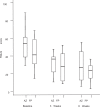Effectiveness of twice daily azelastine nasal spray in patients with seasonal allergic rhinitis
- PMID: 19209282
- PMCID: PMC2621402
- DOI: 10.2147/tcrm.s3229
Effectiveness of twice daily azelastine nasal spray in patients with seasonal allergic rhinitis
Abstract
Azelastine nasal spray (Allergodil((R)), Lastin((R)), Afluon((R)); Meda AB, Stockholm, Sweden) is a fast-acting, efficacious and well-tolerated H1-receptor antagonist for the treatment of rhinitis. In addition it also has mast-cell stabilizing and anti-inflammatory properties, reducing the concentration of leukotrienes, kinins and platelet activating factor in vitro and in vivo, as well as inflammatory cell migration in rhinitis patients. Well-controlled studies in patients with seasonal allergic rhinitis (SAR), perennial rhinitis (PR) or vasomotor rhinitis (VMR) confirm that azelastine nasal spray has a rapid onset of action, and improves nasal symptoms associated with rhinitis such as nasal congestion and post-nasal drip. Azelastine nasal spray is effective at the lower dose of 1 spray as well at a dose of 2 sprays per nostril twice daily, but with an improved tolerability profile compared to the 2-spray per nostril twice daily regimen. Compared with intranasal corticosteroids, azelastine nasal spray has a faster onset of action and a better safety profile, showing at least comparable efficacy with fluticasone propionate (Flonase((R)); GSK, USA), and a superior efficacy to mometasone furoate (Nasonex((R)); Schering Plough, USA). In combination with fluticasone propionate, azelastine nasal spray exhibits greater efficacy than either agent used alone, and this combination may provide benefit for patients with difficult to treat seasonal allergic rhinitis. In addition, azelastine nasal spray can be used on an as-needed basis without compromising clinical efficacy. Compared with oral antihistamines, azelastine nasal spray also demonstrates superior efficacy and a more rapid onset of action, and is effective even in patients who did not respond to previous oral antihistamine therapy. Unlike most oral antihistamines, azelastine nasal spray is effective in alleviating nasal congestion, a particularly bothersome symptom for rhinitis sufferers. Azelastine nasal spray is well tolerated in both adults and children with allergic rhinitis. Bitter taste which seems to be associated with incorrect dosing technique is the most common side effect reported by patients, but this problem can be minimized by correct dosing technique.
Keywords: azelastine nasal spray; intranasal corticosteroids; oral antihistamines; rhinitis; seasonal allergic rhinitis.
Figures








Similar articles
-
Azelastine hydrochloride: a review of pharmacology, pharmacokinetics, clinical efficacy and tolerability.Curr Med Res Opin. 2007 Oct;23(10):2441-52. doi: 10.1185/030079907X226302. Curr Med Res Opin. 2007. PMID: 17723160 Review.
-
Combination therapy with azelastine hydrochloride nasal spray and fluticasone propionate nasal spray in the treatment of patients with seasonal allergic rhinitis.Ann Allergy Asthma Immunol. 2008 Jan;100(1):74-81. doi: 10.1016/S1081-1206(10)60408-5. Ann Allergy Asthma Immunol. 2008. PMID: 18254486 Clinical Trial.
-
Azelastine nasal spray for the treatment of allergic and nonallergic rhinitis.Expert Rev Clin Immunol. 2009 Nov;5(6):659-69. doi: 10.1586/eci.09.38. Expert Rev Clin Immunol. 2009. PMID: 20477689
-
Double-blind trials of azelastine nasal spray monotherapy versus combination therapy with loratadine tablets and beclomethasone nasal spray in patients with seasonal allergic rhinitis. Rhinitis Study Groups.Ann Allergy Asthma Immunol. 1999 Jun;82(6):535-41. doi: 10.1016/s1081-1206(10)63161-4. Ann Allergy Asthma Immunol. 1999. PMID: 10400480 Clinical Trial.
-
Efficacy and safety of azelastine nasal spray for the treatment of allergic rhinitis.J Am Osteopath Assoc. 1999 Jul;99(7 Suppl):S7-12. doi: 10.7556/jaoa.1999.99.7.s7. J Am Osteopath Assoc. 1999. PMID: 10478514 Review.
Cited by
-
Comparison of the Effects of Azelastine and Fluticasone Nasal Sprays in the Treatment of Allergic Rhinitis.Indian J Otolaryngol Head Neck Surg. 2022 Oct;74(Suppl 2):1632-1637. doi: 10.1007/s12070-021-02686-7. Epub 2021 Aug 2. Indian J Otolaryngol Head Neck Surg. 2022. PMID: 36452604 Free PMC article.
-
Comparative study of the efficacy and safety of intranasal azelastine hydrochloride and fluticasone furoate in the treatment of allergic rhinitis.J Family Community Med. 2020 Sep-Dec;27(3):186-191. doi: 10.4103/jfcm.JFCM_103_20. Epub 2020 Sep 25. J Family Community Med. 2020. PMID: 33354149 Free PMC article.
-
The Nose as a Route for Therapy: Part 1. Pharmacotherapy.Front Allergy. 2021 Feb 22;2:638136. doi: 10.3389/falgy.2021.638136. eCollection 2021. Front Allergy. 2021. PMID: 35387039 Free PMC article. Review.
-
The Multidirectional Effect of Azelastine Hydrochloride on Cervical Cancer Cells.Int J Mol Sci. 2022 May 24;23(11):5890. doi: 10.3390/ijms23115890. Int J Mol Sci. 2022. PMID: 35682572 Free PMC article.
-
A four-way, double-blind, randomized, placebo controlled study to determine the efficacy and speed of azelastine nasal spray, versus loratadine, and cetirizine in adult subjects with allergen-induced seasonal allergic rhinitis.Allergy Asthma Clin Immunol. 2013 May 1;9(1):16. doi: 10.1186/1710-1492-9-16. eCollection 2013. Allergy Asthma Clin Immunol. 2013. PMID: 23635091 Free PMC article.
References
-
- Al Suleimani YM, Walker MJA. Allergic rhinitis and its pharmacology. Pharmacol Ther. 2007;114:233–60. - PubMed
-
- Anon. Rochester (NY): Harris Interactive Inc; 2001. Oct 19–21, Physician survey sponsored by the American College of Allergy, Asthma and Immunology.
-
- Anon. 2006Allergies in America: a landmark survey of nasal allergy sufferers HealthSTAR Communications, Inc; Sponsored by Altana Pharma US, Inc. March 1.
-
- Banov CH, Liberman P. Efficacy of azelastine nasal spray in the treatment of vasomotor (perennial nonallergic) rhinitis. Ann Allergy Asthma Immunol. 2001;86:28–35. - PubMed
-
- Baumgarten CR, Petzold U, Dokic D, et al. Modification of allergen-induced symptoms and mediator release by intranasal azelastine. J Pharmacol Ther. 1994;3:43–51.
LinkOut - more resources
Full Text Sources
Other Literature Sources
Medical
Research Materials
Miscellaneous

